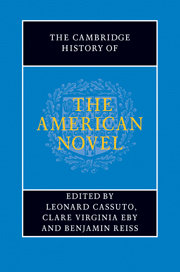Book contents
- Frontmatter
- General Introduction
- PART ONE INVENTING THE AMERICAN NOVEL
- PART TWO REALISM, PROTEST, ACCOMMODATION
- Introduction: realism, protest, accommodation
- 17 Realism and radicalism: the school of Howells
- 18 James, pragmatism, and the realist ideal
- 19 Theories of the American novel in the age of realism
- 20 The novel in postbellum print culture
- 21 Twain, class, and the Gilded Age
- 22 Dreiser and the city
- 23 Novels of civic protest
- 24 Novels of American business, industry, and consumerism
- 25 New Americans and the immigrant novel
- 26 Cather and the regional imagination
- 27 Wharton, marriage, and the New Woman
- 28 The postbellum race novel
- 29 The African American novel after Reconstruction
- 30 The rise of naturalism
- 31 Imagining the frontier
- 32 Imperialism, Orientalism, and empire
- 33 The hemispheric novel in the post-revolutionary era
- 34 The woman's novel beyond sentimentalism
- 35 Dime novels and the rise of mass-market genres
- 36 Readers and reading groups
- PART THREE MODERNISM AND BEYOND
- PART FOUR CONTEMPORARY FORMATIONS
- A selected bibliography
- Index
20 - The novel in postbellum print culture
from PART TWO - REALISM, PROTEST, ACCOMMODATION
Published online by Cambridge University Press: 28 July 2011
- Frontmatter
- General Introduction
- PART ONE INVENTING THE AMERICAN NOVEL
- PART TWO REALISM, PROTEST, ACCOMMODATION
- Introduction: realism, protest, accommodation
- 17 Realism and radicalism: the school of Howells
- 18 James, pragmatism, and the realist ideal
- 19 Theories of the American novel in the age of realism
- 20 The novel in postbellum print culture
- 21 Twain, class, and the Gilded Age
- 22 Dreiser and the city
- 23 Novels of civic protest
- 24 Novels of American business, industry, and consumerism
- 25 New Americans and the immigrant novel
- 26 Cather and the regional imagination
- 27 Wharton, marriage, and the New Woman
- 28 The postbellum race novel
- 29 The African American novel after Reconstruction
- 30 The rise of naturalism
- 31 Imagining the frontier
- 32 Imperialism, Orientalism, and empire
- 33 The hemispheric novel in the post-revolutionary era
- 34 The woman's novel beyond sentimentalism
- 35 Dime novels and the rise of mass-market genres
- 36 Readers and reading groups
- PART THREE MODERNISM AND BEYOND
- PART FOUR CONTEMPORARY FORMATIONS
- A selected bibliography
- Index
Summary
America's runaway bestseller in 1895 was George Du Maurier's Trilby (1894), a novel that surged into prominence and soon receded, leaving behind mainly the epithet “Svengali” and a style of felt hat. Set in mid-century Paris, Trilby nostalgically depicts a bohemian community of artists and their devotion to Trilby O'Ferrall, a tomboyish artist's model who becomes a famous singer under Svengali's hypnotic tutelage. Americans' fascination with Trilby took many forms, and media coverage of the fascination became another manifestation of it. There were Trilby shoes and Trilby sausages, a Trilby ice cream concoction, Trilby clubs and Trilby parties (sometimes featuring Trilby tableaux). A dramatic version of Trilby was a hit; satirical parodies sent up the novel and the play; and because the novel used music in many pivotal scenes, concerts featured the songs in Trilby and new songs inspired by it. Even scandals were folded into Trilby's popularity. The commemorative volume Trilbyana (1895), which reprinted reviews and articles about Trilby's popularity, also documented James McNeill Whistler's charge that the novel libeled him, a controversy about whether Trilby's sexual involvements made the novel unsuitable for public libraries, and allegations that Du Maurier had plagiarized an earlier novel
Given the extraordinary public response to Trilby, its reception has been interpreted as a watershed in book marketing or even a sign of the consolidation of that slippery phenomenon, mass culture. Although “mass-marketed” has become a handy term to indicate publications available to large and diverse readerships, especially non-elite readerships, “mass culture” as a special history as a term designating the effects of large-scale industrial production and distribution on cultural commodities and consumers.
- Type
- Chapter
- Information
- The Cambridge History of the American Novel , pp. 337 - 364Publisher: Cambridge University PressPrint publication year: 2011



